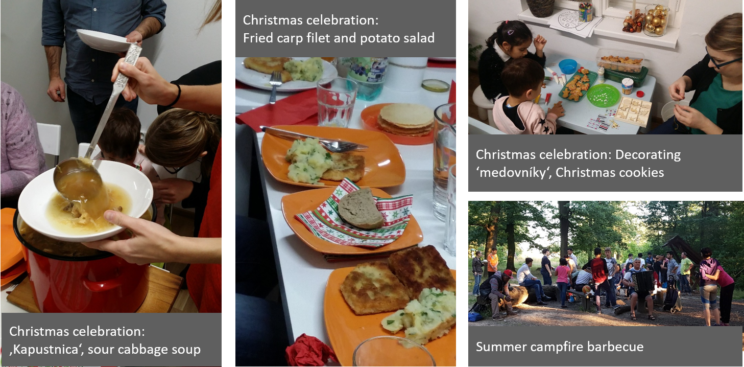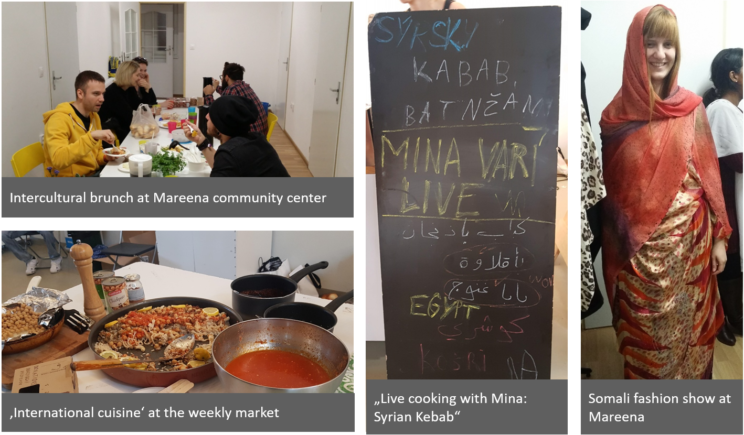“No pizza, Viennese Schnitzel, Goulash, not even a Kebab to go…” This is how the Slovak Catholic Charitas imagines life without migrants under the hashtag #24hwithout. Another picture has the caption „Slovakia would lack many skillful hands and us at home groceries“. The thoughts and pictures that were shared on several social media channels belong to a campaign called “Where is home” which aims to invite people to think about what home means to them, and simultaneously accept that people unlike them might call the same place their “home”.

Migration means food – this impulse, reminder, or warning is shared again and again in multifarious shapes, channels, and designs by people who advocate for migrants’ acceptance in Slovakia. Most events of the organizations I was studying revolved around food. The programs of these NGOs were full of brunches, picnics, barbecues, cooking workshops, and participation in food fairs. The organizations understood food as a vehicle of integration, in its bilateral sense: the accommodation of foreigners into new surroundings, and the attunement of local populations to an increasingly diverse society. How is difference interpreted in these programs of integration via food?
Anthropologists have always paid special attention to the cultural practices surrounding food. Occasions on which food is prepared or shared are predestined to tell us a lot about social patterns, structures, and relations. Mary Douglas suggests that the human body is essentially a symbol of society, and thus “Bodily control is an expression of social control”. In other words, the food is shared with others according to socially defined gradations of distance and intimacy. Similarly, Marshall Sahlins asserts that “Food offered in a generalized way, notably as hospitality, is good relations.. .. Food not offered on the suitable occasion or not taken is bad relations—- In these principles of instrumental food exchange there seems little variation between peoples.”
It is thus no surprise that so many activities of all the organizations I observe revolve around food – shared meals are a universal token of appreciations, they serve to get to know each other, overcome distance, develop intimacy. At the same time, as a long tradition of anthropological theorizing on hospitality attests, rules and role expectations can be constraining or even overwhelming: Hosts are benevolent and generous, guests reciprocate by being grateful and compliant. Consequently, there is a disbalance of power in every hospitality encounter: Hosts have the primacy in deciding on the rules and conditions on which hospitality is granted.
In Slovakia, hospitality at large, manifesting in the country’s acceptance of migrants, is closely connected to the hospitality industry. A look at Bratislava’s gastronomic landscape conveys the image of a commencing immigration society: There may not be a lot of diversity, but certain products have become firmly established parts of the city’s gastronomic layout. But non-Slovak food is not automatically associated with migration. Especially sushi and pizza may or may not be prepared by Italian resp. Japanese chefs. Vietnamese food is an exception because a sizeable amount of Vietnamese migrated to Slovakia under Socialism. Kebab, by contrast, is widely marked and considered as “Turkish” food, although a minority of Kebab places are Turkish-owned (many are Afghan, Syrian or Persian).

There are two major ways in which food comes to feature in NGOs integration programs: I call them educative hospitality and gastro-cultural representation. The first is, of course, directed towards foreigners: Organizations practice hospitality towards “their” foreigners by inviting them to shared meals. The staff of the organizations claimed that their Christmas parties, picnics, and barbecues were a gift for their “friends”, to give them the feeling that they are welcome, appreciated guests, worth making an effort for, thus setting a counterpoint to experiences of rejection and hostility. They also claim that food (especially Slovak food) is rife with symbolic meanings, which allows particularly insightful access to Slovak culture, hospitality, sociality, family customs, and traditions, etc. – in other words, food as a shortcut to cultural intimacy.

At the same time, foreigners are made ambassadors of their countries‘ resp. cultures: They are asked to host cooking workshops, cook for food fairs and festivals, bring their food to potluck dinners, or organize theme evenings on their countries which often involves, dress, dance, food, and drink. These programs are directed to the Slovak public: They should provide locals and newcomers the opportunity to mingle and socialize, but also to experience difference as something positive, exciting. Some NGOs also frame this as an applied critique of the restrictive roles of host and guest: A guest taking the position of the host, even if temporarily, also means a destabilization of established hierarchies. If withholding the opportunity to reciprocate is a way of psychological subordination, the possibility to “give back” can be liberating.
Now I want to take a closer look at one project and its engagement with questions of difference and community, the #plnezuby-campaign. This campaign was developed by Mareena, a civic association in Bratislava. Mareena coordinates volunteers who support foreigners, they also offer language courses and a program of public events for both foreigners and old-established Slovaks.
On 20th June 2019, the International Day of Refugees, Mareena launched a big campaign directed at the general public with the food topic at its center: The slogan sounded “Cudzincov máme plné zuby”. The Slovak idiom Mát niečeho plné zuby means to be sick of something. Literally, it translates to “I have the mouth full of something”. This means the slogan has the double meaning of “I am fed up with foreigners” and “I am fed by foreigners”. A provocative slogan which, of course, invites recipients to juxtapose stereotypes and actual contributions of migrants The staff of Mareena are aware of the view present in the media and politics, of refugees as perpetrators or as helpless and voiceless victims, and wanted to give a better example. They are very sensitive to harmful and discriminatory language. For example, they debated intensely on whether they should even include the word “foreigner” in their mission statement. After all, they wanted a welcoming environment in which humans are respected as individuals and in which differences like race, ethnicity or country of origin don’t matter!

Little later, Mareena presented the svetová gastromapa (global food map) of Bratislava on which a selection of restaurants with food from all over the world are registered. They offered the map in exchange for donations for the community center. On the map, restaurants are organized in national categories: Italian, Indian, Turkish, Vietnamese restaurants all have their own columns. A special section is dedicated to Slovak chefs “who know how to prepare foreign food so authentically that we cannot imagine this map without them”. On their social media, Mareena explained that “Our #plnezuby campaign … is here to highlight what we as people have in common. No matter where we’re from, we always share a common ground that we can build on. We like our phos, bureks, and kebabs and have already made foreign cuisines part of our lives. Why not let people that brought them to us become part of our lives, too?” In short, the intention of the project is to project the appreciation of foreign foods that already exist and project it onto living human beings – migrants.
Obviously, Mareena did something different here from what they usually do. They did not frame difference as something that is insignificant or should be ignored, they highlighted it. In an interview on national radio, the manager of Mareena stressed that their goal was to show that “the foreigners who live here and function successfully, do not pose a threat to anyone, no: they even create a product which we, Slovaks, really like”. She painted a picture of biopolitically “worthy guests”, strangers who are different in an “enjoyable” way.
What are the implications of associating migration mainly with food? Gastronomy is a service industry whose workers are certainly not among the most respected, and foreign foods are very often in the cheapish, fast-food sector, understood as a quick budget bite rather than chef-y, expertly prepared delicacies. The perception of “migrant” food matches the societal condescension towards migrants. Plus, most of the foods that appear as tokens of foreign food appreciation have their roots in groups that have no problem with social acceptance: Wiener Schnitzel, Sushi, Ramen, Pizza, Goulash, and Tacos. No one, not even most right-leaning xenophobes, has ever demanded to throw Italians or Austrians out of the country, and very few would turn against Japanese or Mexicans. The liberal educators’ belief that the right rejects any sort of migration equally only helps right-wing debaters ward off accusations easily and without getting at the gist of the matter: Racism and, to a bigger degree even, Islamophobia. Kebab is the only food from the Near or Middle East that has become a local staple, and African food is completely absent. Of course, one could also push the conversation into the direction of using novel and exciting foods to stimulate confrontation with these parts of the world, but then the “what would we do without our cherished foreign foods”-trope doesn’t work. And, as experience shows, “new” foods only acquire wide acceptance (beyond the realm of adventurous cosmopolitan foodies) after having been around for decades and become widely decoupled from their contexts of origin.
A substantial part of foreigners living in Slovakia is forced into precarious, physically demanding, oftentimes irregular positions in gastronomy. Foreign degrees are rarely recognized, and jobs in takeaways or restaurants remain among the most accessible ones. There is also a network effect here: Foreigners are more likely to be employed by other foreigners because Slovaks are hesitant to do so. One would maybe expect these places to become meaningful in terms of belonging and memory, as community hubs where minorities and diasporas indulge in the tastes and smells from home. But this is not the case: Employees rarely prepare the cuisine they grew up with. One person from Afghanistan told me that a vast majority of employees in Indian restaurants in Slovakia are, in fact, Afghan. This should not be surprising: India, in the Slovak consciousness, is less strange and less connected to Islam than Afghanistan. Specializing in this cuisine is a far less risky business choice. But it urges one to ask whether the quest for „authenticity“ which the trope of enjoyable difference promotes isn’t really a farce. In theory, a nationality or ethnicity that matches the establishments’ cuisine is considered as a warrantor of quality. Why else are Slovak chefs singled out for “accomplishing” authenticity whereas it is tacitly assumed from “ethnic” gastro-entrepreneurs? In reality, however, guests are often unaware of or uninterested in the background of the people who prepare their food. Also, it is a widespread and by no means exclusively Slovak phenomenon that “ethnic” chefs accommodate their cooking to the European palate and scale down “exoticism” to an agreeable measure so as not to scare off potential customers.
Migrants occasionally also resisted the recruitment as culinary ambassadors. They were tired of cooking or because it means a lot of effort which they feel they do not benefit from sufficiently. Others, as mentioned before, are eager to deliver their new surroundings their favorite dish as a kind of guests’ present, happy to finally be able to “give back” to their “hosts”.
I think we can conclude that migrants react differently to how their difference is portrayed in Mareena’s PR work. But the campaign does not only showcase enjoyable difference, no: it also invites to indulge in sameness: Everyone has to eat; everyone likes tasty food; every culture has managed to create unique and delicious culinary products. These deeply human conditions should remind us that we are all the same. I think this is a very common trope in pop culture and food media – Netflix‘ „Ugly delicious“ show with David Chang is a prominent example. One final thought that speaks to this invocation of the universality of appetite is from Georg Simmel’s treatise on “The stranger” (1908). He says that the fact that difference seems to linger in all encounters with strangers and is so difficult to overcome has less to do with the “otherness” in and for itself, but with the nature of the similarities: In his words:
In some cases, perhaps the more general, at least the more unsurmountable, strangeness is not due to different and ununderstandable matters. It is rather caused by the fact that similarity, harmony, and nearness are accompanied by the feeling that they are not really the unique property of this particular relationship: they are something more general, something which potentially prevails between the partners and an indeterminate number of others, and therefore gives the relation, which alone was realized, no inner and exclusive necessity.” (Simmel 1908)
Maybe that’s one of the reasons why it is difficult to derive from general similarities a sense of belonging or mutual appreciation.
An earlier version of this text was presented at 2020 EASA conference on the panel ‘Memory, Materiality and (Non)-Belonging – Minority Restaurants and Food Practices in a Global Perspective’
